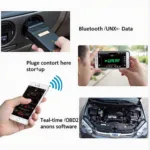The OBD2 fault code P0030 indicates a problem with the heated oxygen sensor (HO2S) control circuit, specifically for Bank 1 Sensor 1. This code can be frustrating, but understanding its meaning and potential causes can empower you to address the issue effectively. This article will dive deep into P0030, explaining its causes, symptoms, diagnostic procedures, and potential solutions.
What Does OBD2 Code P0030 Mean?
The P0030 code specifically refers to a malfunction in the heater control circuit of the first oxygen sensor on Bank 1. Bank 1 refers to the side of the engine that contains cylinder number one. Sensor 1 is the upstream oxygen sensor, located before the catalytic converter. The heated oxygen sensor (HO2S) plays a crucial role in monitoring the exhaust gas oxygen content, which the engine control module (ECM) uses to adjust the air/fuel mixture for optimal performance and emissions. A faulty heater circuit can delay the sensor’s ability to provide accurate readings, leading to performance issues and increased emissions.
Common Causes of OBD2 Code P0030
Several factors can trigger the P0030 code. Understanding these causes can help you narrow down the problem and expedite the diagnostic process. Some of the most common causes include a malfunctioning oxygen sensor, damaged wiring in the sensor’s circuit, a blown fuse, or even a faulty ECM. Corrosion, especially in areas exposed to road salt, can also disrupt the sensor’s circuitry.
- Faulty Oxygen Sensor: The sensor itself may be damaged or worn out, requiring replacement.
- Wiring Issues: Damaged, corroded, or loose wiring in the sensor’s circuit can interrupt the heater circuit’s operation.
- Blown Fuse: A blown fuse in the HO2S heater circuit can cut off power to the heater.
- ECM Problems: While less common, a faulty ECM can also cause the P0030 code.
Symptoms of a P0030 Code
The symptoms of a P0030 code can vary depending on the severity of the issue and the specific vehicle. However, some common signs include:
- Check Engine Light: The most obvious symptom is the illuminated check engine light on your dashboard.
- Reduced Fuel Economy: A malfunctioning oxygen sensor can cause the engine to run rich, leading to decreased fuel efficiency.
- Rough Idle or Misfires: The engine may idle roughly or experience misfires due to the incorrect air/fuel mixture.
- Failed Emissions Test: The vehicle may fail an emissions test due to increased emissions.
Diagnosing OBD2 Code P0030
Diagnosing the P0030 code requires a systematic approach. First, you’ll need an obd2 code po0030 scanner to retrieve the code. Then, visually inspect the wiring and connector for any obvious damage. Check for blown fuses related to the HO2S circuit. Using a multimeter, test the voltage and resistance of the sensor and its wiring. If the wiring and fuse are okay, the next step is often to test the oxygen sensor itself using a multimeter to check its resistance and heater circuit operation.
“Accurate diagnosis is key. Don’t just throw parts at the problem. Take the time to systematically check the wiring, fuse, and sensor itself.” – John Miller, Automotive Diagnostic Technician.
How to Fix OBD2 Code P0030
Depending on the diagnosis, the solution to a P0030 code might involve replacing the oxygen sensor, repairing damaged wiring, or replacing a blown fuse. In some rare cases, the ECM might need replacement or reprogramming, but this is usually a last resort. It’s always best to start with the simplest and most likely solutions first, such as checking the fuse and wiring.
- Replace the Oxygen Sensor: If the sensor is faulty, it will need to be replaced.
- Repair Wiring: Repair or replace any damaged or corroded wiring in the sensor circuit.
- Replace Fuse: If the fuse is blown, replace it with a new one of the correct amperage.
“A quality OBD2 scanner is an invaluable tool for any car owner. It empowers you to understand and address issues like P0030 effectively.” – Sarah Chen, Automotive Engineer.
Conclusion
The OBD2 fault code P0030 indicates a problem with the heated oxygen sensor control circuit on Bank 1 Sensor 1. By understanding the code, its potential causes, and the diagnostic process, you can address the issue efficiently and prevent further complications. Addressing the P0030 code promptly can not only restore your vehicle’s performance and fuel economy but also ensure you pass your next emissions test. Remember, a ford obd2 code p0030 could also indicate this problem. Check also the obd2 ready indicator to be sure. Sometimes, you might encounter similar codes like p0037 obd2 code or obd2 p0037, which relate to the same circuit but on different sensors.
FAQ
- Can I drive with a P0030 code? While you can technically drive with a P0030 code, it’s not recommended.
- How much does it cost to fix a P0030 code? The cost can vary, but typically ranges from $50 to $300.
- How can I prevent a P0030 code? Regular maintenance and inspections can help prevent this code.
- Is a P0030 code serious? While not immediately dangerous, it can lead to more serious problems if ignored.
- What tools do I need to diagnose a P0030 code? You’ll need an OBD2 scanner and a multimeter.
- Can I fix a P0030 code myself? With some basic mechanical skills, you may be able to fix it yourself.
- What happens if I ignore a P0030 code? Ignoring the code can lead to decreased fuel economy, performance issues, and potential damage to the catalytic converter.
Need help? Contact us via WhatsApp: +1(641)206-8880, Email: [email protected] or visit us at 789 Elm Street, San Francisco, CA 94102, USA. We have a 24/7 customer support team.
